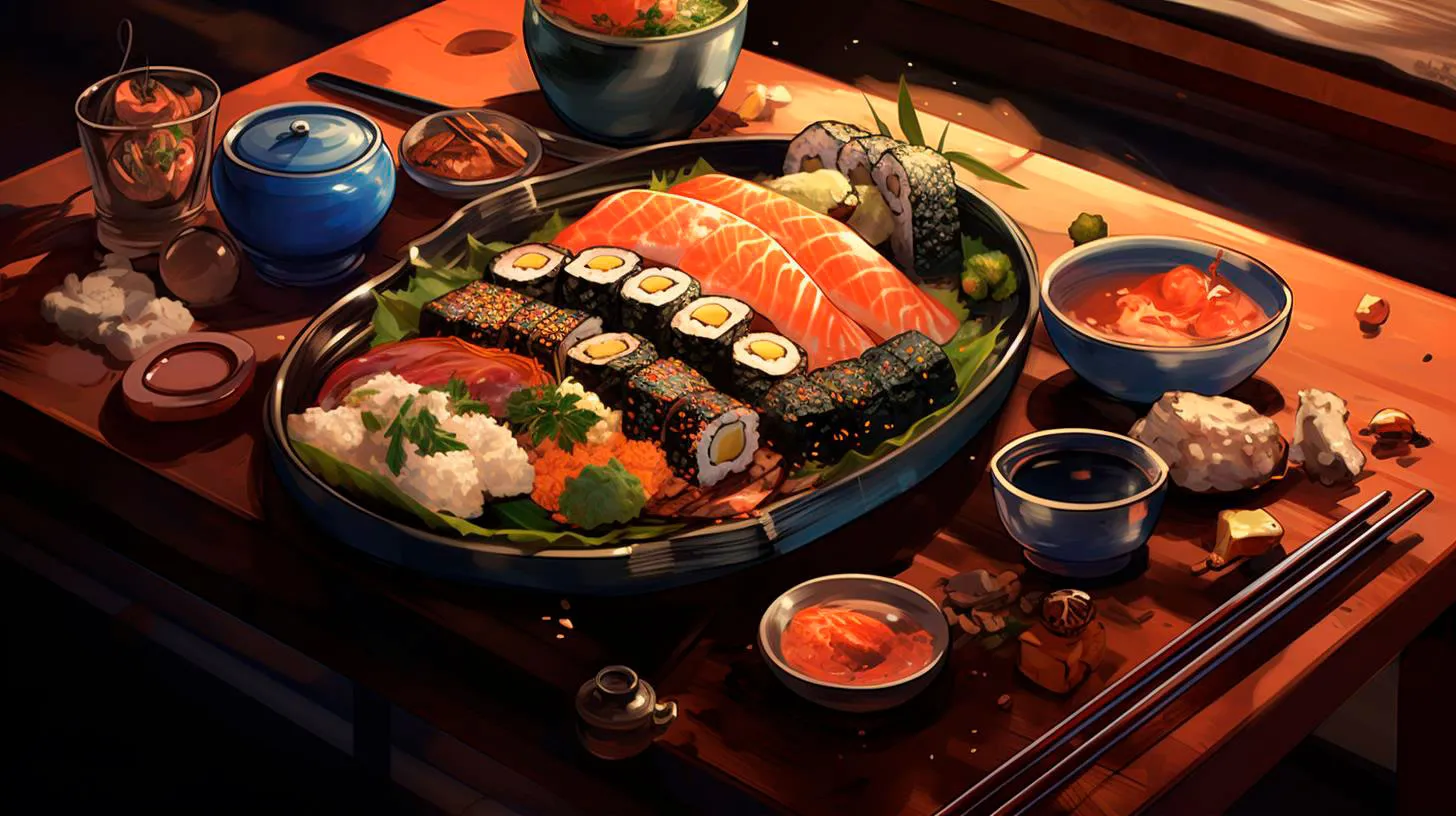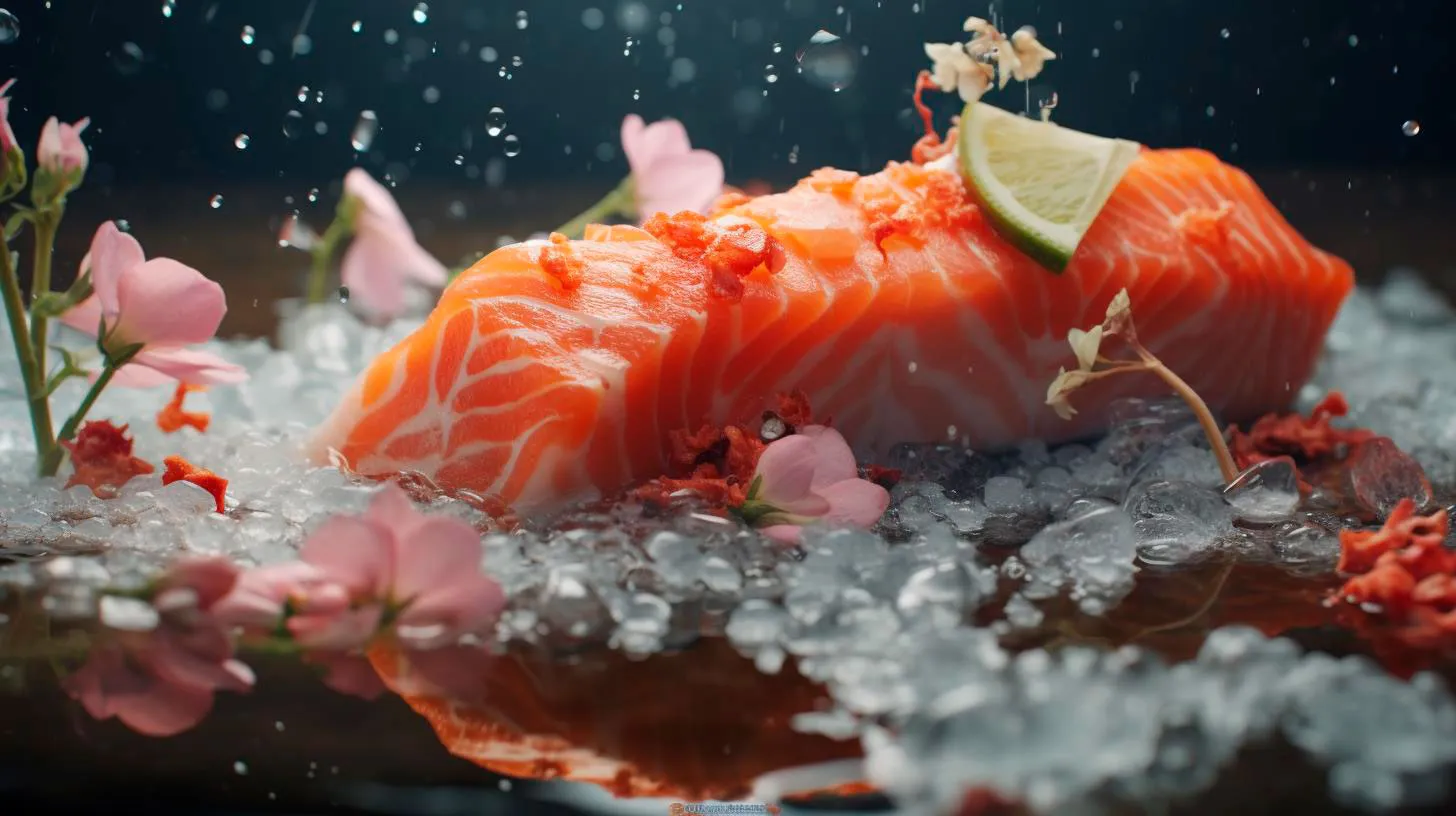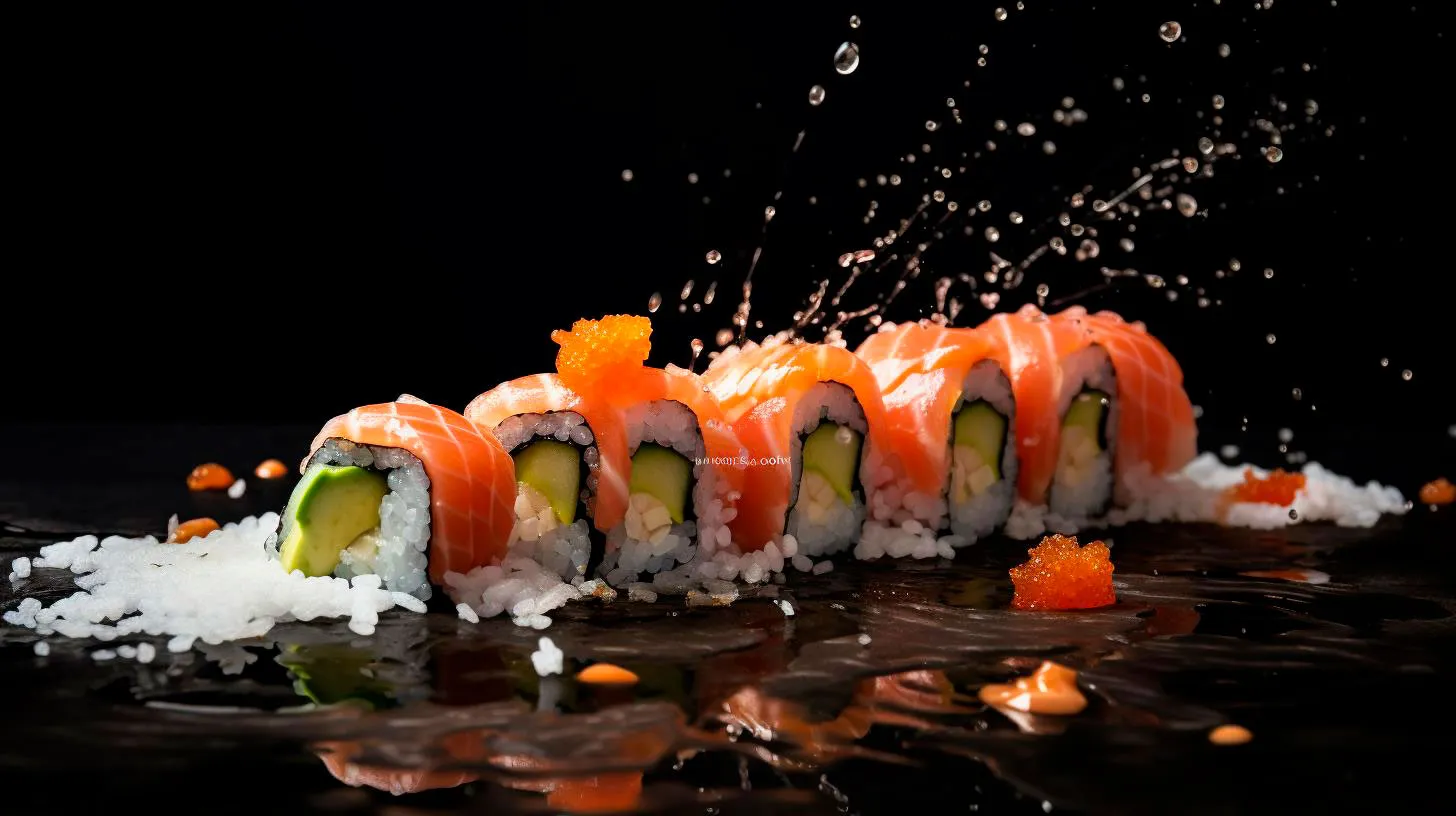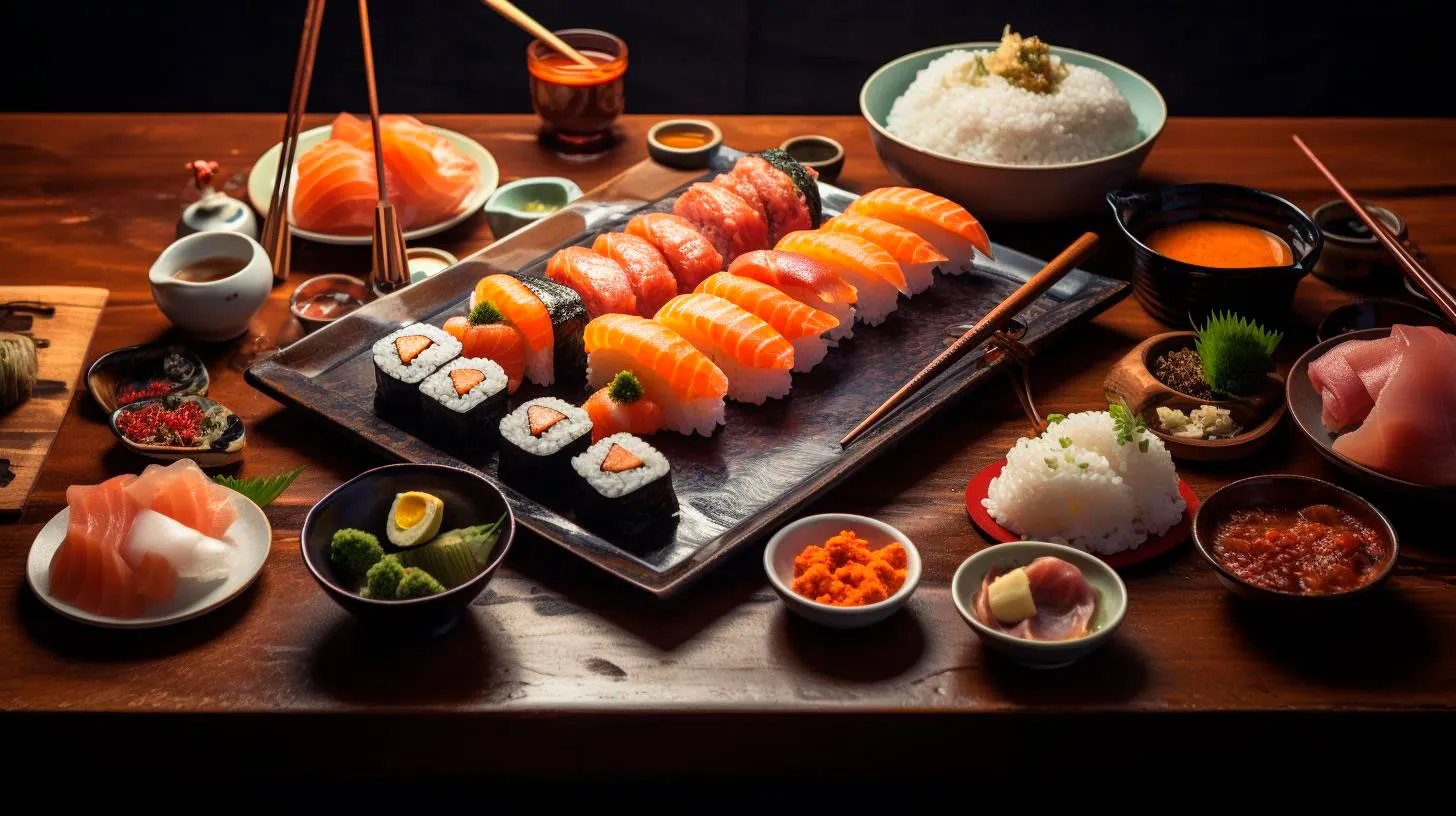Crafting Sushi: Showcasing the Chef Personality on a Plate
The Creative Process Behind Sushi Mastery
Crafting sushi is not just about rolling fish and rice together; it involves a carefully thought-out process that requires precision, technique, and innovation. Let’s dive into the creative process behind sushi mastery:
1. Ingredient Selection
A sushi chef’s journey begins with selecting the finest ingredients. Quality seafood, such as tuna, salmon, and shrimp, is vital to create delectable sushi. Additionally, fresh and seasonal vegetables and herbs are chosen to add flavor, texture, and vibrant colors to the dish.
2. Rice Preparation
Sushi rice is the foundation of every roll. Chefs meticulously wash, cook, and season the rice with a mixture of rice vinegar, sugar, and salt. The rice should have the perfect balance of stickiness and moisture, allowing it to hold its shape when rolled.
3. Slicing Techniques
The chef’s knife skills are put to the test when it comes to slicing the fish. Each slice must be precise, ensuring a perfect balance between thickness and tenderness. The way the fish is cut can greatly impact the texture and taste of the sushi.
4. Roll Types and Assembly
Chefs showcase their creativity through various roll types, such as maki, nigiri, and temaki. Maki, the most common type, involves rolling the ingredients in seaweed (nori) and sushi rice. Nigiri features a slice of fish or seafood atop a small mound of rice. Temaki, on the other hand, is a cone-shaped hand roll.
Once the roll type is chosen, chefs assemble the ingredients, ensuring a visually appealing presentation. The way the ingredients are layered and arranged on the plate reflects the chef’s artistic touch.
The Artistic Element – A Showcasing of Personality
Sushi is not just about taste; it is a work of art that reflects the personality and style of the chef. Here’s how chefs showcase their personality through sushi:
1. Flair for Fusion
Sushi chefs often infuse their cultural background or culinary influences into the traditional sushi-making process. By incorporating unique ingredients or flavor combinations, they create fusion rolls that surprise and delight customers. This innovation adds excitement and a personal touch to the dining experience.
2. Design Aesthetics
Sushi presentation is an essential part of the dining experience. Chefs use their artistic eye to arrange the sushi pieces and accompanying sauces in a visually pleasing manner. Colors, shapes, and arrangement are all taken into consideration to create an aesthetically pleasing plate that truly captivates the diner.
3. Omakase Chef’s Selection
Omakase, meaning “chef’s choice,” is a popular way to experience the chef’s creativity firsthand. Customers entrust the chef to select the freshest ingredients and create a customized sushi tasting menu. This allows the chef to showcase their skills and surprise the guest with a unique culinary journey.
4. Personalized Specials
Sushi chefs often create personalized specials, introducing new flavors or ingredients to their loyal customers. These specials can range from seasonal rolls to signature sauces, providing a novel experience for diners and showcasing the chef’s versatility.
Key Takeaways from the World of Sushi
As we explore the world of sushi and the chef’s personality it encapsulates, here are some key takeaways to keep in mind:
- Sushi making involves a meticulous process that requires precision and technique.
- Ingredient selection is crucial to ensure quality and enhance flavors.
- Sushi chefs infuse their personality and creativity through fusion rolls and personalized specials.
- Sushi is not only about taste but also an artistic presentation that reflects the chef’s style.
- Omakase offers a unique dining experience, allowing chefs to showcase their skills and surprise guests.
Remember, when you enjoy a plate of sushi, you’re not only tasting the flavors but also experiencing the chef’s passion and artistry. So, next time you indulge in this Japanese delicacy, take a moment to appreciate the craftsmanship behind it and the chef’s personality displayed on your plate.
Sushi Rolls: Aesthetic Marvels with Unique Personalities
With their diverse range of flavors, unique presentations, and delightful textures, sushi rolls are not only a feast for the senses, but they also possess their own individual personalities that make them stand out. In this article, we will dive into the world of sushi rolls, exploring their aesthetic marvels and how each roll comes with its own distinct character.
Flavors that Excite the Palate
One of the defining characteristics of sushi rolls is their incredible flavor profiles. Whether you’re a fan of the savory notes of seafood or the delicate sweetness of fresh vegetables, sushi rolls offer a tantalizing array of tastes to suit every preference. From the classic California roll with creamy avocado and succulent crab meat to the spicy tuna roll that packs a punch of heat, each roll boasts a unique combination of ingredients that come together harmoniously in every bite.
Key Takeaway: Sushi rolls come in a range of flavors, allowing you to explore various taste sensations and cater to your personal preferences.
The Artistry of Presentation
One of the reasons why sushi rolls have gained such popularity is their visually stunning presentation. Japanese cuisine has always focused on aesthetics, and sushi rolls are no exception. Each roll is carefully crafted, with the ingredients skillfully arranged to create an eye-catching display. The vibrant colors of fresh fish, crisp vegetables, and delicate rice are a feast for the eyes. Moreover, the meticulous attention to detail and precision in sushi roll preparation reflect the rich cultural heritage and craftsmanship of Japan.
Key Takeaway: Sushi rolls are not just a treat for your taste buds, but also a feast for your eyes, offering an artistic and visually appealing dining experience.
Textures that Mesmerize
While flavor and presentation are important, sushi rolls also offer an incredible variety of textures that add depth to the dining experience. From the smoothness of sashimi to the crunchiness of tempura flakes, each component of a sushi roll contributes to its unique texture profile. Moreover, the contrast between soft and chewy rice, velvety fish, and crisp vegetables creates a textural harmony that keeps you coming back for more.
Key Takeaway: Sushi rolls provide a delightful play on textures, offering a sensory adventure with each bite.
Health Benefits in Every Bite
Beyond their aesthetic appeal, sushi rolls also offer numerous health benefits. Fish, a key ingredient in many sushi rolls, is an excellent source of lean protein and omega-3 fatty acids, which are essential for heart health and brain function. Additionally, the inclusion of fresh vegetables and seaweed in sushi rolls provides essential vitamins, minerals, and antioxidants that support overall well-being. This combination of taste and health makes sushi rolls a popular choice for those seeking a nutritious meal.
Key Takeaway: Sushi rolls are not only delicious but also offer the added advantage of being a nutritious dining option.
Captivating the World with Diversity
As sushi rolls continue to charm food enthusiasts around the globe, their popularity has led to the emergence of countless variations. From the traditional nigiri and maki rolls to modern interpretations like the dragon roll and spicy salmon roll, sushi rolls offer something to cater to every palate. This diversity ensures that there is always a new flavor combination or technique to discover and enjoy.
Key Takeaway: Sushi rolls are ever-evolving, with an endless array of combinations, keeping your dining experience exciting and full of delightful surprises.
In Conclusion
Sushi rolls truly are aesthetic marvels with their own unique personalities. From the flavors that excite your palate to the artistry of their presentation and the textures that mesmerize, each sushi roll offers a multi-sensory journey. Additionally, the health benefits and the diverse range of options make sushi rolls an appealing choice for any food lover. So, the next time you savor a sushi roll, take a moment to appreciate the culinary craftsmanship and the delightful experience it brings.
The Art of Plating: Elevating Sushi’s Character
The art of plating sushi plays a crucial role in enhancing its character, elevating it from a mere dish to an aesthetic experience. In this article, we dive into the world of sushi plating and explore the techniques that make it a true masterpiece.
The Significance of Sushi Plating
Sushi is not just about combining ingredients; it is an art form that requires meticulous attention to detail. The process of plating sushi involves much more than arranging neatly sliced fish and rice on a plate. It has the power to transform a simple piece of sushi into an aesthetically pleasing masterpiece that can make your mouth water even before taking a bite.
Some key reasons why sushi plating is crucial:
- Visual Appeal: Well-plated sushi creates a visually striking presentation that entices diners.
- Enhancing Texture and Flavors: Thoughtful plating techniques can enhance the texture and flavors of each ingredient.
- Aesthetic Harmony: Balancing colors, shapes, and sizes on the plate creates a visually harmonious presentation.
- Cultural Expression: Sushi plating reflects the deep-rooted cultural traditions and history of Japan.
Techniques for Sushi Plating
1. Balance and Harmony
Achieving balance and harmony in sushi plating involves carefully arranging different components. Here are some techniques to consider:
- Select colors that complement each other, such as vibrant greens from wasabi, reds from tuna, and yellows from pickled ginger.
- Vary textures by using crispy tempura, soft fish, or creamy seafood to create an exciting contrast.
- Consider shapes and sizes of ingredients to add visual interest and create balance on the plate.
2. Attention to Detail
Attention to detail is crucial when plating sushi. Every grain of rice, slice of fish, and drizzle of sauce matters. The smallest adjustment can make a significant difference. Some key points to remember:
- Ensure symmetrical and precise alignment of ingredients.
- Use tweezers to carefully position tiny garnishes such as microgreens or sesame seeds.
- Mind the spacing between each piece of sushi for an organized and visually appealing presentation.
3. Plate Presentation
The choice of plate can greatly impact the overall presentation of sushi. Here are some aspects to consider:
- Use traditional Japanese plates or modern serving dishes that align with the theme of the sushi.
- Consider the color and material of the plate to enhance the visual appeal of the sushi.
- Use negative space strategically to create a sense of balance and highlight the sushi.
Key Takeaways
When it comes to sushi, the art of plating has a significant role in elevating its character. By considering elements such as balance, harmony, attention to detail, and plate presentation, sushi chefs can transform a simple dish into an extraordinary culinary experience. The art of plating not only enhances visual appeal but also showcases the rich cultural heritage of Japan.
Key takeaways from the article:
- Plating sushi is an art form that goes beyond arranging ingredients.
- Well-plated sushi enhances visual appeal, texture, and flavor.
- Techniques like balance, attention to detail, and plate selection are crucial for sushi plating.
- Plating reflects the cultural traditions and history of Japan.
In conclusion, the art of plating sushi is an intricate process that requires creativity, precision, and an understanding of the cultural significance. Next time you indulge in a plate of sushi, take a moment to appreciate the efforts made by the sushi chef in creating not just a meal but a visual masterpiece for you to enjoy.
The Role of Colors and Textures in Sushi Personality
So, let’s embark on this flavorful journey together!
The Importance of Colors
Colors play a significant role in shaping our perception of food, and sushi is no exception. Just like a vibrant painting, the colors of sushi provide visual cues that entice us to dive in. Here’s why colors matter in sushi:
- Appetizing Appeal: Bright and vivid colors in sushi, such as reds, greens, and yellows, stimulate our appetite and make the dish visually appealing.
- Freshness Indicators: The colors of sushi ingredients, like the deep orange of tuna and the vibrant pink of salmon, indicate their freshness and quality.
- Artistic Expression: Sushi chefs use a variety of colorful ingredients, such as pickled radishes, cucumber, and Tobiko (roe), to create visually stunning and appetizing sushi rolls.
It’s fascinating how the colors of sushi can influence our experience even before we take the first bite.
The Power of Textures
While colors add visual appeal, textures provide an extra dimension to the sushi-eating experience. The combination of smooth, crunchy, and chewy textures creates a delightful symphony for our taste buds. Here’s why textures matter in sushi:
- Mouthfeel: The textures of sushi ingredients, such as the creamy avocado, crispy tempura, and tender fish, create a unique mouthfeel that adds depth and complexity to each bite.
- Contrast: Combining different textures in a single sushi roll, like a crunchy exterior and a soft interior, creates an exciting contrast that keeps our taste buds engaged.
- Sensory Experience: The marriage of colors and textures in sushi elevates our sensory experience, allowing us to savor each bite on multiple levels.
The artful combination of colors and textures in sushi is a testament to the meticulous craftsmanship of sushi chefs.
Key Takeaways
Now that we understand the role of colors and textures in sushi, let’s summarize the key takeaways:
- Colors in sushi stimulate our appetite and indicate the freshness of ingredients.
- Colorful ingredients like pickled radishes and roe add artistic flair and visual appeal.
- Textures in sushi, from creamy to crunchy, create a delightful mouthfeel.
- Contrasting textures in sushi rolls provide an exciting sensory experience.
- The combination of colors and textures make sushi a true culinary masterpiece.
Next time you sit down to enjoy a plate of sushi, take a moment to appreciate the vibrant colors and intricate textures that make each bite a work of art. Remember, sushi is not just food; it’s an experience for all your senses!
Industry Statistics
Did you know? According to a study by the International Sushi Academy:
- 85% of people consider the colors of sushi when choosing their order.
- 78% of sushi enthusiasts believe that textures greatly affect their overall enjoyment of the dish.
- 63% of sushi restaurants have seen an increase in customer satisfaction after implementing visually appealing sushi presentations.
These statistics further emphasize the importance of colors and textures in the world of sushi.
As we conclude this blog post, let the vibrant colors and tantalizing textures of sushi inspire you to appreciate the artistry behind each roll. Bon appétit!



